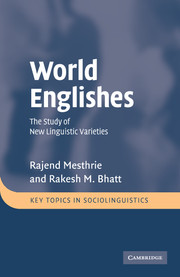Book contents
- Frontmatter
- Contents
- List of figures
- List of tables
- Preface
- Acknowledgements
- List of abbreviations
- 1 History: the spread of English
- 2 Structural features of New Englishes I: morphology and phrasal syntax
- 3 Structural features of New Englishes II: cross-clausal syntax and syntactic theory
- 4 More on structure: lexis and phonology
- 5 Pragmatics and discourse
- 6 Language contact and language acquisition issues in New English research
- 7 Conclusion: current trends in the spread of English
- Glossary
- Bibliography
- Author index
- Subject index
7 - Conclusion: current trends in the spread of English
Published online by Cambridge University Press: 05 September 2012
- Frontmatter
- Contents
- List of figures
- List of tables
- Preface
- Acknowledgements
- List of abbreviations
- 1 History: the spread of English
- 2 Structural features of New Englishes I: morphology and phrasal syntax
- 3 Structural features of New Englishes II: cross-clausal syntax and syntactic theory
- 4 More on structure: lexis and phonology
- 5 Pragmatics and discourse
- 6 Language contact and language acquisition issues in New English research
- 7 Conclusion: current trends in the spread of English
- Glossary
- Bibliography
- Author index
- Subject index
Summary
INTRODUCTION
This chapter rounds off the study of WEs by examining them in the context of linguistic aspects of globalisation and some practical issues surrounding it. The main areas covered are WEs in education, special purpose international communication like air traffic control, the growing call-centre industry in the Outer Circle and the further spread of English in Europe.
SOME EDUCATIONAL ISSUES
In previous chapters we focused on the characteristics of New Englishes that set them apart from metropolitan varieties. These structural and discourse characteristics lead us to characterise individual New Englishes as varieties in their own right. That is, they are treated as relatively autonomous varieties, or dialects with a special status, namely being L2 varieties, not frequently used in the home. Crucially a New English like that of Sri Lanka is not invented anew with each generation of learners. Earlier generations are responsible for effectively laying down tracks that subsequent generations were to follow and modify. Thus Sri Lankan English is not simply ‘English in Sri Lanka’, but a variety with a certain regional and social identity, one of its characteristics being, as Kachru (1982) and others have stressed, acculturation to the languages, environment and sociopolitical activities in the society. A relevant question that has arisen is whether the New English should be overtly recognised within the educational system, if it is the tacit norm that people follow.
- Type
- Chapter
- Information
- World EnglishesThe Study of New Linguistic Varieties, pp. 200 - 224Publisher: Cambridge University PressPrint publication year: 2008



